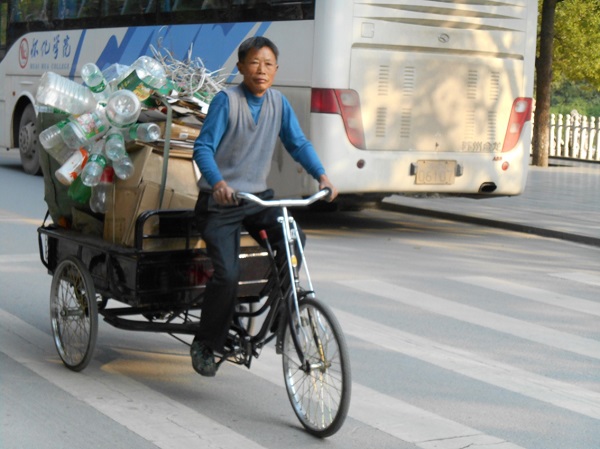
I’m overwhelmed with the problems and needs of this world, and sometimes I don’t know where to begin.
We all know that we should reduce our dependence on plastic, and I wish my region would jump on the bandwagon to ban plastic bags. It can be done, but in the meantime, I have decided that I don’t have to wait until a law is in place to do the right thing, right now.
I have developed a good habit of always bringing my own recyclable bags when I go shopping. If I happen to be out without a bag, I often carry the items in my arms, or stuff them into my purse (along with the receipt, in case I’m accused of shoplifting). When friends tell me they usually bring bags with them but forgot this time—just this one time, they say—I tell them this is no longer an excuse. What would you do if you lived in California or Europe?
We might as well get on board now.
~
Best way to to keep your core pelvic and org@sm muscles strong and resilient? Here’s the coveted apparatus that makes this possible >>
~
When my daughter told me that she decided to stop buying bottled water, I decided to follow her example. So, when someone offers me a bottle of water, or when I am out on a walk and get thirsty, I just say no. I am not going to die of thirst. If I’m that thirsty, I can find a restroom and drink water from the sink. Knowing that I am not going to buy bottled water on the run helps me remember to bring a container with me. And remembering that my daughter is doing the same thing gives me a little more incentive.
We’re in this together.
Mindfulness means giving pause over habits we’ve never thought about before and taking a first small step toward change. Doing just one thing with intention can lead others to do just one thing, too. And doing one thing leads to doing another thing.
What else can we do? One thing at a time—that’s how anything happens.
They say that doing something for 21 days creates a habit. The yoga studio where I practice cleverly offered 21 days of unlimited yoga classes for $21, knowing full well that I would be hooked after that, and more than willing to pay the market price.
Now that I have the “no bottled water” habit in place, I want to do something else—or should I say, not do something else—in order to be the change I want to see in the world.
I decided to stop using plastic straws after I heard that straws are especially pernicious to ocean creatures. Every time I am given a straw at a restaurant, I recall the image of a sea turtle that was rescued by scientists who had to remove a plastic straw that was “fully embedded” in its nose. Ugh, what would it feel like to have a straw fully embedded in my own nose, or in my pet’s nose? I can do without plastic straws, so I will do without them.
Plastic straws are altogether unnecessary—except maybe when included with those drink boxes marketed for children. Perhaps these products could be modified to exclude the use of straws; there’s an invention waiting to happen. It used to be that straws were made from thick waxed paper, with those convenient little knees built in. I wonder if these are still for sale.
The last time I went out to lunch with a friend, the server gave us each a straw; I put mine aside and, after a moment, my friend did, too. He had noticed my wordless but deliberate choice not to use a plastic straw, and he followed suit.
What’s next? Carry-out containers. I am so sick of being handed my leftover food in a flimsy plastic, aluminum, or Styrofoam container that I have to figure out how to dispose of when I get home. Until we find an environmentally sustainable way to recycle Styrofoam, I don’t want to be caught using it, in any form.
I once read a suggestion about bringing our own carry-out containers when we go out to eat, so the last time I went out, I decided to try the idea.
My friend asked, “Are you sure you’re allowed to do that?” “Why not?” I replied.
When I handed the server my repurposed container, she did a double-take, but then accepted it with an appreciative smile. She got my message. Maybe I was the first customer to have done this, but there always has to be a first. Now, I try to remember to keep a container and lid in my car at all times, just in case.
What’s next? According to nonprofit foundations, chefs, and food waste advocates, it’s tackling the dilemma of food waste Nari Kye, one of the directors of “Wasted: The Story of Food Waste,” notes, “I think people are ready. I think there could be a big cultural push like there was for recycling years ago or anti-littering or wearing seat belts.”
Anthony Bourdain, executive producer, offers statistics: “Forty percent of the food in America gets thrown out. Ninety percent of the food that gets thrown out in America ends up in landfills, which doesn’t decompose properly and releases methane gas. The average family of four will throw out $1,500 worth of food each year.”
Many of us already take our own shopping bags to the grocery store, decline the offer of a plastic straw, and bring our own carry-out containers to public eateries. Are we ready to start repurposing leftovers, too?
Here are some steps we can take when reconsidering the way we use food:
Reduce: When we buy food in bulk, we end up wasting food, either because it gets stale or spoils before we get around to using it. Sometimes we have so much food in the fridge that we can’t make up our minds what to eat. This is a First World problem. In most other countries, people shop daily at street markets or the neighborhood store for that day’s food—just enough to make dinner, with some leftovers for lunch. Although we’ve been programmed to believe this is a wasteful practice because it means going to the store every day, it actually reduces food waste. Don’t overbuy to begin with.
Reuse: Eating leftovers allows us to get creative in the kitchen. In my family, we would save the leftovers for about five days and then think of the best way to use them in a recipe. Our favorite reused food recipe is stuffed peppers: any type of leftover grain (rice, quinoa, bulgur, even pasta), any type of beans or meat, any type of soup, any type of vegetables. Mix together and add cheese, spices, and perhaps some freshly diced garlic and onion. Then stuff into blanched, halved bell or poblano peppers. Bake at 350 degrees for about 45 minutes and savor the blend of the week’s flavors.
Recycle: One of the best ways to recycle food waste is by having a compost pile. Keep a lidded bucket or plastic tub near the kitchen sink. No matter how moldy or stinky it is, this food waste will make great compost. Some folks prefer collecting vegetable scraps in the freezer to deal with later. If you don’t have a garden, you can give your unwanted leftovers to a gardener-friend.
Repurpose: The Irish call the family pig “the man who pays the rent.” In the past, thrifty households kept chickens and pigs as a way to repurpose their precious food waste. While dogs and cats are not supposed to eat our leftover food, chickens and pigs can thrive on the food we would ordinarily throw away. Waste not, want not.
In these days of major overwhelm, it’s easy to just sit back and take a ride on the slippery slide toward hopelessness. But be encouraged. You can make a difference in your world by taking just one small, mindful step. Choose to do just one thing, whether it’s to stick with a recycling habit or reduce food waste in your own kitchen.
Do just one thing—and I promise you, the next step will appear.
~
~
Author: Connie Foss
Image: Author’s Own
Editor: Nicole Cameron
Ready to join?
Hey, thanks so much for reading! Elephant offers 1 article every month for free.
If you want more, grab a subscription for unlimited reads for $5/year (normally, it's $108/year, and the discount ends soon).
And clearly you appreciate mindfulness with a sense of humor and integrity! Why not join the Elephant community, become an Elephriend?
Your investment will help Elephant Journal invest in our editors and writers who promote your values to create the change you want to see in your world!
Already have an account? Log in.
Ready to join?
Hey, thanks so much for reading! Elephant offers 1 article every month for free.
If you want more, grab a subscription for unlimited reads for $5/year (normally, it's $108/year, and the discount ends soon).
And clearly you appreciate mindfulness with a sense of humor and integrity! Why not join the Elephant community, become an Elephriend?
Your investment will help Elephant Journal invest in our editors and writers who promote your values to create the change you want to see in your world!
Already have an account? Log in.
Ready to join?
Hey, thanks so much for reading! Elephant offers 1 article every month for free.
If you want more, grab a subscription for unlimited reads for $5/year (normally, it's $108/year, and the discount ends soon).
And clearly you appreciate mindfulness with a sense of humor and integrity! Why not join the Elephant community, become an Elephriend?
Your investment will help Elephant Journal invest in our editors and writers who promote your values to create the change you want to see in your world!
Already have an account? Log in.

 Share on bsky
Share on bsky






Read 1 comment and reply